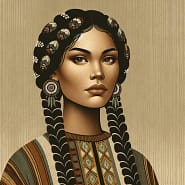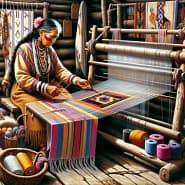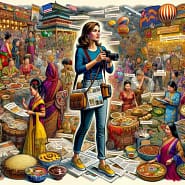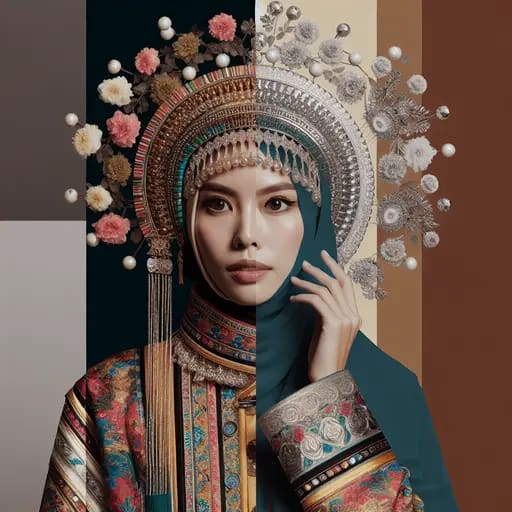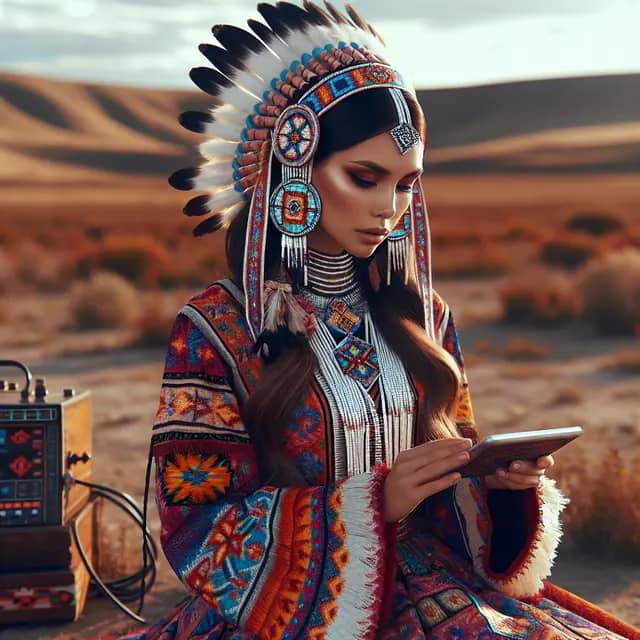Introduction: Exploring the Relationship Between Fashion and Cultural Identity
Have you ever thought about your attire and wondered how influenced it is by your culture? Fashion, in many ways, reflects our historical and societal narratives, which are deeply rooted in cultural identities. This article delves into the nuanced relationship between Fashion and Cultural Identity.
Before we delve into the various nuances of this entwined relationship, here are key themes we will explore:
- Historical background on how fashion has influenced cultural identity over the years.
- The role of traditional clothing in preserving and expressing cultural identity.
- The impact of globalization on fashion and cultural identity.
- The influence of social media on shaping cultural identity through fashion.
- Challenges faced by minority cultures in maintaining their unique fashion traditions.
- How fashion can at times be a form of cultural appropriation and its implications.
- The rise of conscious fashion and its role in promoting cultural diversity.
- Reflecting on the future of fashion and its evolving impact on cultural identity.
The bond between the cultural identity we relate to and the fashion choices we make is inherently connected, shaping our everyday lives in subtle yet profound ways. From the tribal tattoos of the Maori people in New Zealand to the vibrant turbans worn in Rajasthan, India, fashion across the globe plays a pivotal role in reflecting and preserving cultural identity.
Let’s embark on this journey of understanding the impact of fashion on cultural identity, giving you a fresh perspective on how clothes, accessories, and styles narrate stories of who we are and where we come from. Stay with us as we unpack layers of history, socio-cultural dynamics, and evolving fashion trends that extensively shape our cultural identities.
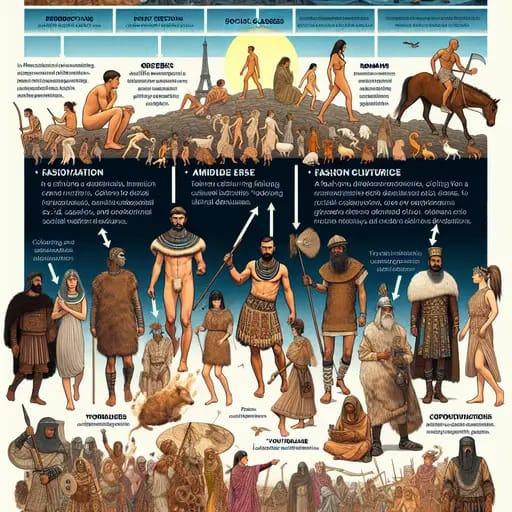
Historical Background on How Fashion Has Influenced Cultural Identity Over the Years
From time immemorial, fashion has been an integral part of society, acting as a mirror to the cultural, social, and economic changes and influencing cultural identity in multiple ways. It is a form of self-expression, portraying individual and group identity, giving insights into different cultures’ history, and creating a sense of belonging and community.
- Prehistoric Era: Early humans used fashion as a means to protect against harsh weather conditions. However, the variations in clothing styles, made from the skins of animals, also became associated with tribal identities.
- Ancient Civilizations: In the glorious Egyptian, Greek, Roman and Indus Civilizations, fashion played a critical role in differentiating between social classes, genders, and professions. Intricate dress-designs were indicative of power and status. (Wikipedia)
- Middle Ages to Modern Times: With the passage of time, fashion became increasingly complex and diversified. In Medieval and Renaissance Europe, for instance, clothing revealed one’s social status and profession. By the 18th and 19th centuries, fashion became a significant reflection of cultural shifts and societal movements.
- 20th Century: This era witnessed the evolution of fashion trends in line with significant socio-political upheavals. Post-World War II, fashion became an outlet for expressing individuality and cultural identity. The rise of ‘Youthquake’ fashion evidenced fashion’s impact on cultural identity, highlighting generational divide and showcasing youth culture.
- 21st Century: With globalization, fashion has become more accessible, creating a culturally diverse fashion scene. The digital revolution has also allowed individuals to showcase their cultural identity through fashion.
Fashion’s journey over the years hints at its inherent power, not just as an aesthetic element, but as a profound influencer of cultural identity. From what seemed into a mere act of wearing clothes, fashion has evolved to become a medium of communicating traditions, ideals, and cultural nuances. In the next section, we’ll delve deeper into the role of traditional clothing in this process.
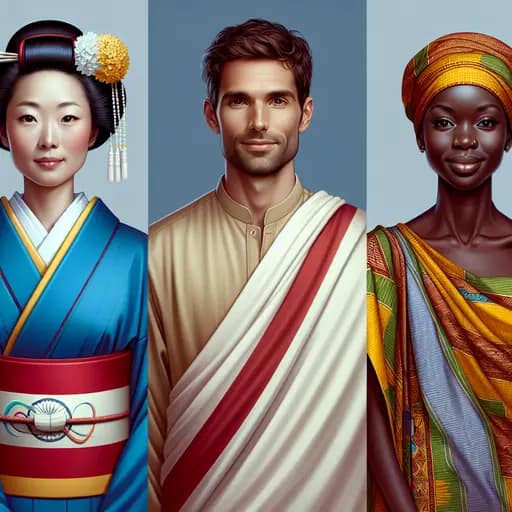
The Role of Traditional Clothing in Preserving and Expressing Cultural Identity
In today’s rapidly globalizing world, the significance of traditional clothing in preserving and expressing cultural identity cannot be overstated. Clothing is much more than just a form of adornment – it holds deep cultural significance and history. By donning traditional clothing, individuals reconnect with their heritage, demonstrating their pride and respect for their cultural background.
- Historical significance: Many traditional clothing pieces have a long history attached to them. They tell stories about our ancestors and provide insights into ancient cultures and civilizations.
- Preservation of cultural identity: Traditional clothing serves as a symbol of cultural identity. It allows individuals to proudly display their roots and keep their traditions alive.
- Expression of individuality: Each unique traditional clothing piece is representative of a distinct culture and its ideals. This variety helps promote diversity and encourages individuals to express their unique cultural identities.
- Ceremonial role: Traditional clothing often plays an important role in cultural rituals and ceremonies, reinforcing a sense of belonging within a community.
Note the role that traditional clothing plays in preserving and expressing cultural identity as we delve into specific examples in different geographical regions.
- The Kimono in Japan: Symbolizing grace and elegance, the Kimono is an emblematic Japanese garment. Despite Western clothing styles becoming more common, the Kimono continues to hold cultural significance and is worn on special occasions, serving as a reminder of Japanese history and heritage.
- The Sari in India: Representing diversity and tradition, the Sari is a timeless Indian attire that is still widely worn across the country. Each region of India has its specific style of draping a Sari, showcasing the country’s diverse cultural identity.
- The Dashiki in West Africa: Bright and colorful, the Dashiki has become a powerful symbol of African culture. Although it is seen worn globally, the Dashiki is a critical element of West African cultural identity.
In summary, the role of traditional clothing in preserving and expressing cultural identity is vast. It acts as a communicative medium, allowing individuals to express their cultural roots and contribute to the preservation of their culture’s history. As society progresses, it becomes even more vital to recognize and respect the cultural significance that traditional clothing holds worldwide.
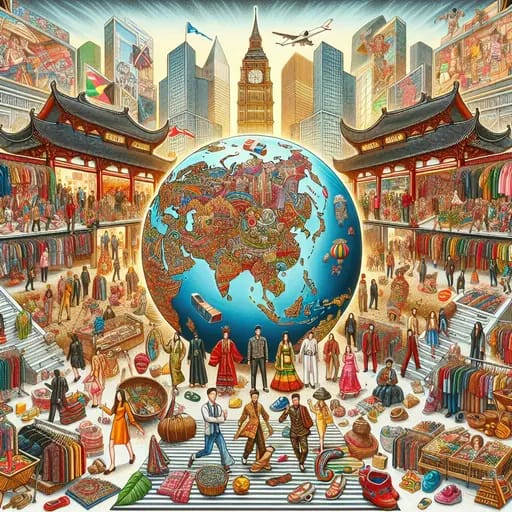
The Impact of Globalization on Fashion and Cultural Identity
Globalization is one of the most influential forces shaping the world today. Its effects are deeply embedded in various areas of society, and the fashion industry isn’t an exception. On one hand, globalization has necessitated a mutual sharing and integration of cultures leading to a cosmopolitan fashion scene. On the other hand, it has sparked controversies on cultural identity erosion and cultural appropriation. The intersection of fashion, globalization, and cultural identity is surely complex and thought-provoking.
Globalization and the Fashion Industry
- Access to International Markets: With globalization, fashion brands have been able to showcase their designs on global platforms, thus influencing trends on an unprecedented scale. In addition, consumers also have increased access to international brands due to online retailers, which adds another layer of multicultural influences.
- Production and Supply Chain: Globalization has transformed the production and supply chain of the fashion industry. Fashion brands now source materials and manufacture their products in different parts of the world, exposing them to a wider range of cultural influences.
Globalization’s Impact on Cultural Identity
While globalization has fostered cultural interaction, the fear of cultural identity loss lurks. This fear stems from the global dominance of Western fashion that can potentially overshadow traditional clothing. However, many cultures have used the global platform to fuse local fashion elements with global trends, thus creating a unique style that still preserves their cultural identity.
- Homogenization of Fashion: Globalization can lead to a homogenization of fashion, where local distinctive styles are replaced by global fashion trends, leading to a loss in cultural identity. Hence, the challenge lies in balancing between maintaining cultural uniqueness and embracing global trends.
- Preservation of Cultural Identity: On a positive note, the globalization of fashion could potentially serve as a means of preserving cultural identity by sparking interest in traditional clothing that might be declining in popularity.
In Summary
Globalization’s impact on fashion and cultural identity can’t be overlooked. It presents both opportunities and challenges to the fashion industry. As the fashion world continues to evolve into a more global industry, it’s imperative to strike a balance between maintaining cultural identity and embracing global influences.
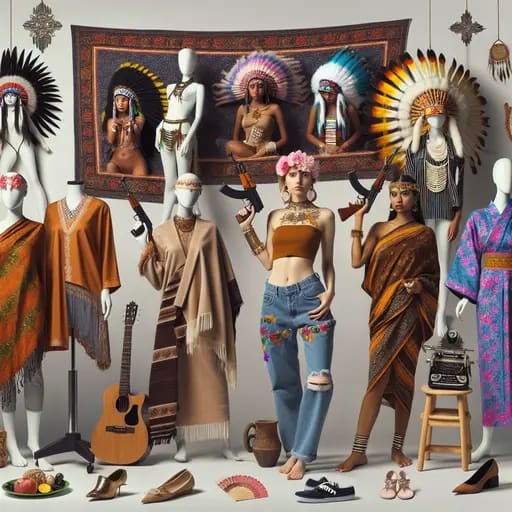
Fashion as a Form of Cultural Appropriation and its Implications
In our examination of The Impact of Fashion on Cultural Identity, it is essential to highlight the implications of fashion as a form of cultural appropriation. Over time, various cultures’ traditional styles have found their way into the mainstream fashion industry, frequently without an understanding or respect for the cultural significance behind them.
Understanding Cultural Appropriation in Fashion
Cultural appropriation often manifests when elements of a minority culture are adopted by members of a dominant culture, the fashion industry being a global player in assisting this process. This occurrence can be particularly harmful, merely turning meaningful cultural artefacts into passing trends for those outside the culture. Some key instances of cultural appropriation in fashion include:
- The use of sacred Native American headdresses as fashion accessories
- Wearing bindis and henna as just another festival trend
- Turned African prints and kimonos into Western casual wear
We can’t overstate that the adoption of these cultural elements goes beyond simply borrowing — it often carries implications of historic oppression and power imbalances.
Understanding the Implications of Cultural Appropriation
There are several implications when fashion serves as a form of cultural appropriation:
- Erosion of Cultural Identity: Appropriation can dilute the meaning of these cultural elements, slowly eroding the identity of the culture they represent.
- Economic Exploitation: Often, the original creators of these cultural styles do not receive fair compensation for their work, with major fashion labels reaping the benefits instead.
- Perpetuation of Stereotypes: When cultural elements are employed randomly or without context, this can perpetuate harmful stereotypes, further marginalizing already oppressed communities.
Cultural appropriation in fashion raises questions about consent, credit, and compensation to the affected cultures. It’s a call for global fashion consumers and designers to reflect on their practices, understanding the cultures they are influenced by, and engage with them respectfully.
The consequences of cultural appropriation in fashion illustrates the intricate connection between fashion and cultural identity. It suggests the urgency of fostering an informed dialogue about clothing, identity, and respect for cultural diversity.
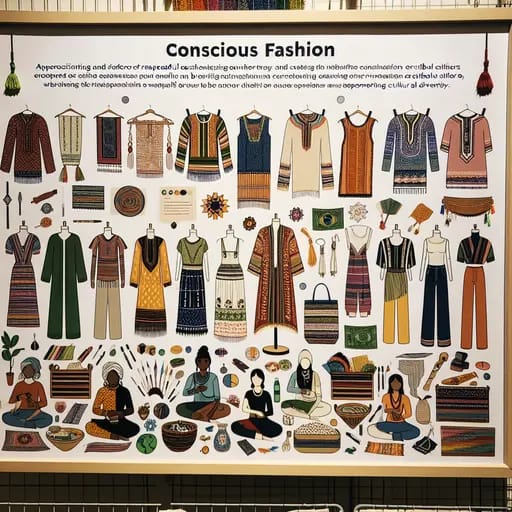
The Rise of Conscious Fashion and Its Role in Promoting Cultural Diversity
In a world increasingly dominated by technology and globalization, the conscious fashion industry emerges as a countermeasure to the disparagement of cultures. It propels the promotion of cultural diversity, making a significant impact on cultural identity. As the moniker suggests, conscious fashion is all about awareness and transformation. Not just concerning the environment, but also addressing the cultural implications of fashion.
Understanding Conscious Fashion
- Conscious fashion refers to the mindful approach towards creating and consuming fashion – considering its environmental, social and cultural dimensions.
- It entails using ethical production methods, maintaining sustainability, promoting cultural diversity, and avoiding cultural appropriation.
Promotion of Cultural Diversity
So how does conscious fashion align with cultural diversity? Let’s highlight the key ways:
- Fostering Respect: Conscious fashion encourages recognition and respect for different cultures. It’s about appreciating the cultural significance behind fashion trends and avoiding the insensitive use of cultural elements.
- Empowering Artisans: Many conscious fashion brands are working directly with artisans from various cultures worldwide, ensuring their skills and cultural values are preserved in the process.
- Preserving Cultural Identity: By promoting artisanal and traditional clothing, conscious fashion aids in the preservation of cultural identities. It validates these practices and secures them a respected place in the global fashion industry.
Encouraging Cultural Exchange
In addition to cultural preservation, conscious fashion facilitates cultural exchange. Respectful sharing and borrowing from different cultures can enrich our wardrobes and our understanding of global cultures.
Further, when done right, it can boost cultural appreciation and dismantle stereotypes. For instance, projects such as ‘The Cultural Intellectual Property Rights Initiative’ supports the safe sharing of cultural heritage and encourages acknowledgment and benefit-sharing.
Conclusion
In conclusion, the rise of conscious fashion and its role in promoting cultural diversity underscores the fashion industry’s potential to contribute positively to society. As consumers and creators, the onus is on us to support brands that align with these values, preserving the diverse tapestry of our world’s cultural identities.
Stay connected as we continue to delve into the impact of fashion on cultural identity. In the next section, we will explore the influence of social media on shaping cultural identity through fashion.
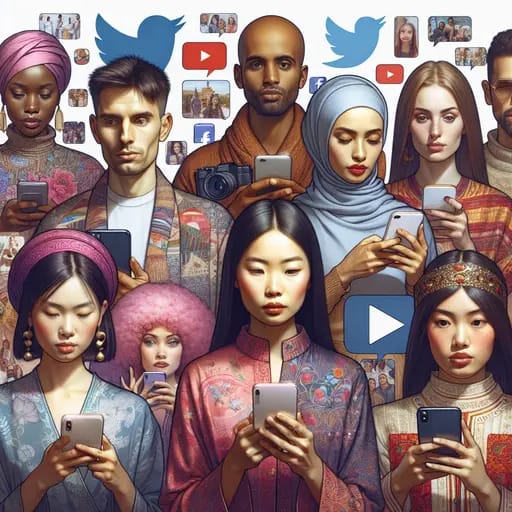
The Influence of Social Media on Shaping Cultural Identity Through Fashion
Social Media has remarkably transcended to become an integral part of our daily lives. While its impact is far-reaching across several aspects of our existence, one area where its influence looms large is the world of fashion. Social media platforms have become the new gateways to fashion trends, style inspiration and more fundamentally, an avenue for shaping and expressing cultural identity.
This section of our article will delve into exploring the intriguing realm of social media’s dual role: as a powerful influencer in the world of fashion, and its implications in molding or impacting cultural identity.
Key Highlights:
- Role of influencers and their impact on fashion trends and cultural identity
- The democratization of fashion through social media
- Cultural representation in digital fashion: A force for inclusivity, or a new wave of appropriation?
In a world where influencers and fashion bloggers from different corners of the globe can share a model shot or a style tip with just a click, the fashion scene has significantly been democratized. At the surface level, this has increased overall fashion consciousness, but springing forth from this development is a subtler, deeper impact on cultural identities.
The Role of Influencers
Influencers often tend to express their personal style that is underpinned by their cultural backgrounds, at the same time, catering to global trends. This digital diffusion of cultural styles can also be seen as a form of preserving and expressing cultural identity. However, we must also examine the potentially negative impact of appropriation and cultural dilution.
The Democratization of Fashion
Before the advent of social media, the fashion industry was primarily controlled by designers, fashion houses, and media giants. Today, Instagrammers, YouTubers, and TikTokers stand shoulder-to-shoulder with major fashion designers impacting global sartorial directions. True to its democratic spirit, social media empowers anyone with an internet connection to contribute to the global fashion narrative. This shift has provided a platform for otherwise marginalized or undiscovered cultures to showcase their unique fashion sensibilities and cultural identities.
Cultural Representation in Digital Fashion: A Force for Inclusivity or a Wave of Appropriation?
Digital fashion platforms like Instagram, Pinterest, and Snapchat have become arenas for showcasing diverse cultural fashion. While this may be a way to celebrate global cultural diversity, it raises concerns about cultural appropriation, or the misuse of elements from another culture without understanding or respect. Gauging the balance between representation and appropriation continues to be a weighty task.
As we progress through the age, we see fashion as not just an avenue to create variety but also as a conduit to reinforce our cultural identity. Social media, as an inseparable component of modern fashion, builds bridges, and also ignites discussions about culture, inclusivity, and appropriation.
To further comprehend the role of fashion in shaping cultural identity, we invite you to explore the following sections that delve into the challenges faced by minority cultures in maintaining their unique fashion traditions, and the future of fashion and its evolving impact on cultural identity.
Continue to: Challenges Faced by Minority Cultures in Maintaining Their Unique Fashion Traditions.
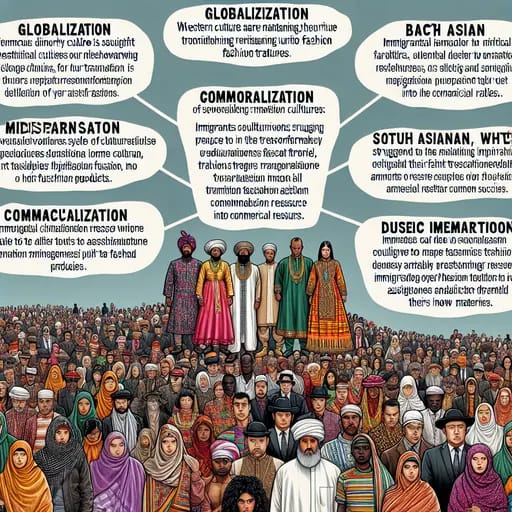
Challenges Faced by Minority Cultures in Maintaining Their Unique Fashion Traditions
The process of preserving cultural identity through fashion traditions is often hindered by various challenges. Particularly for minority cultures, maintaining this distinct identity requires overcoming certain significant barriers. This section explores some of these key challenges:
- Globalization: With the advent globalization, western clothing styles are now omnipresent, often overshadowing the unique fashion traditions of minority cultures. This makes it difficult for these cultures to maintain their own fashion identities.
- Commercialization: The transformation of traditional attire into commercial products is another challenge. While this can lead to mainstream recognition, it may result in dilution or misrepresentation of the authentic cultural significance.
- Social Perception and Stigmatization: Minority cultures often face social pressure to align with popular fashion trends. This can deter individuals from adhering to their traditional clothing and further erode cultural identities.
- Relocation and Assimilation: Immigrants often struggle to maintain their fashion traditions due to pressure to assimilate into their new society. Their traditional outfits may take a backseat whilst adjusting to the mainstream fashion.
Besides these considerations, minority cultures navigate additional obstacles such as a lack of resources, legal impediments, and discrepancies in the availability of traditional raw materials. In the following sections, we will discuss the potential future of fashion amidst these challenges and consider solutions geared towards fostering cultural diversity and inclusivity.
As we delve deeper into this discussion, it is relevant to acknowledge the emerging trend of conscious fashion and the rise of social media, both of which have profound effects on cultural identities shaped through fashion. Join us in exploring these trends in our next section: “The rise of conscious fashion and its role in promoting cultural diversity”.
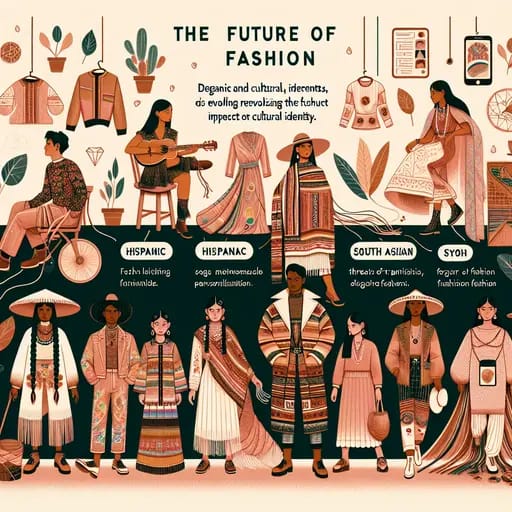
The Future of Fashion and its Evolving Impact on Cultural Identity
As we move forward in our fast-paced, ever-evolving world, the impact of fashion on cultural identity continues to transform and adapt. As a key indicator of cultural dynamics, fashion offers us a glimpse into the future of cultural identity. But, how exactly is fashion shaping our cultural identities in the new age?
- Embracing Diversity and Inclusivity: Future fashion is expected to become more diverse and inclusive. This progress will allow for an enhanced emphasis on individual and national cultural identities, fueling a global appreciation for unique cultural aesthetics and values.
- Technological Integration: The advent and integration of technology in the fashion world, notably through digital fashion, will radically alter our relationship with clothes and our cultural identities. This new medium will allow for greater personalisation and expression of cultural identity.
- Environmentally Conscious Fashion: As we move towards a future increasingly concerned about our planet, sustainable and ethical fashion will gain traction. This shift towards ‘conscious fashion’ can strengthen cultural identities that value nature and sustainability.
- Endurance of Traditional Fashion: Just as cultures persist over time, so too will traditional fashion – it will continue to serve as a part of cultural identity. Balancing these aspects with evolving fashion trends will be a fascinating journey.
Gender norms are also being challenged, ultimately impacting cultural identities. Androgynous, unisex, or gender-fluid fashion styles are growing in popularity, which can expand definitions and expressions of gender within cultural identities. Undeniably, fashion’s future is a reflection of our evolving culture and collective identity.
Regardless of the changes and advancements that will come, fashion will continue to be a significant expression of cultural identity. It will keep mirroring our beliefs, our traditions, and our aspirations – serving as an indicator of who we are as individuals and as a society. Therefore, the significance of cultural identity in future fashion is something that is not just expected, but highly anticipated.
Gaze into the future of fashion and its impact on cultural identity, foresee changes, understand implications, and prepare for a sartorial encounter that is as unique as every culture across the globe.

Conclusion: Reflecting on the Intricate Connection Between Fashion and Cultural Identity
In light of the focus on the impact of fashion on cultural identity throughout this article, the conclusion serves as an opportunity to reflect on this intricate connection. From fashion’s historical influence on cultural identity, the effects of globalization, to the rise of conscious fashion, several factors weave into the contextual fabric fashion and culture.
- Historical Background: Through examining the history of fashion, we can draw a clear line of how it paralleled the evolution of cultures over time. Clothes were not just a necessity but a tool for communicating societal, political, and economic status. In essence, fashion indeed delegated and continues to shape cultural identity.
- Global Influence: Globalization has undeniably transformed the fashion landscape, leading to a convergence of style worldwide. However, it has been both a blessing and a curse by promoting cultural interflow but risking the erosion of distinct cultural fashion identities.
- Cultural Appropriation: Fashion has often borrowed from diverse cultures, which brought concerns about cultural appropriation. The culture behind fashion must always be respected, celebrating its diversity without exploitation.
- Conscious Fashion: The rise of conscious fashion provides hope for a more respectful and inclusive future. By creating space for representation and recognition of diverse cultural identities, it’s a move towards a more sustainable and empathetic fashion world.
- Social Media: The digital age has given prominence to social media influencers, altering cultural norms and making unprecedented impacts in the fashion scene. It becomes vital that representations of cultural identities via fashion remain genuine and respectful.
- Cultural Challenges: Minority cultures often face obstacles in maintaining their unique fashion traditions in the global fashion industry. Increasing advocacy and support for these cultures can ensure that their fashion identity continues to thrive.
- Future Outlook: Fashion is restless, continuously evolving alongside society, driven by cultural shifts. The future of fashion, its ability to respect and represent an ever-diverse globe, may lie in increased awareness and conscious consumption.
In conclusion, the exploration of the complex connection between fashion and cultural identity is a fascinating, complex and ongoing conversation. The beauty of fashion lies not only in the aesthetic appeal but also in the power it possesses to tell stories and shape identities. As society continues to grow in understanding, so too should the symbiotic relationship between fashion and cultural identity.

